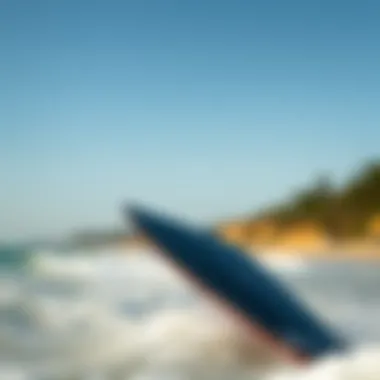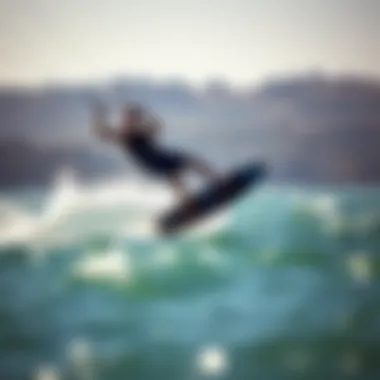Carbon Boards in Kiteboarding: Structure and Benefits


Intro
Kiteboarding, a thrilling blend of surfing and paragliding, has seen remarkable changes in its gear, particularly in the materials used for boards. One material that stands head and shoulders above the rest is carbon fiber. Known for its lightness and strength, carbon boards are revolutionizing the sport, enabling riders to push their limits like never before. This exploration details the structural properties of carbon boards, the benefits they offer over traditional materials, and the innovations shaping their future.
Through this article, we will analyze key performance metrics such as speed, maneuverability, and durability, while also touching on user experiences that underscore the advantages of these boards. It is essential for both seasoned riders and beginners to stay abreast of the latest trends in equipment technology, making informed decisions critical for their kiteboarding adventures. With insights into best practices for caring for your gear and a look ahead at what's next in board technology, we'll guide you in elevating your kiteboarding experience.
Techniques for Kiteboarding Enthusiasts
Beginner Techniques
For those just beginning in kiteboarding, mastering foundational techniques is crucial. This includes controlling the kite, understanding how to harness the wind, and getting comfortable riding on the board.
Some beginner tips include:
- Understand wind direction: Position yourself according to the wind to ensure optimal kite control.
- Practice board starts: Learning to balance on the board while it gets pulled by the kite is essential. Keep your knees bent and look up at the kite to maintain balance.
- Learn to steer the kite effectively: Small movements of the control bar can result in significant changes in response from the kite. Practice gentle and smooth movements.
Advanced Maneuvers
As riders gain confidence, there are several advanced maneuvers that can be explored. These techniques not only enhance skills but also elevate the riding experience:
- Jumping: Improving your ability to jump involves perfecting your take-off timing with the kite's pull and learning to land safely.
- Tricks and Spins: Once in the air, mixing in 180s or 360s adds flair to your maneuvering.
- Handling Higher Winds: Develop the skill to ride in stronger winds, where a sturdy carbon board excels, due to its excellent structural integrity and responsiveness.
"Carbon fibre boards provide unmatched performance and durability, making them a favorite among both amateurs and pros in kiteboarding."
Equipment Reviews
Kite Reviews
In the realm of kiteboarding, the kite is just as crucial as the board. A well-matched kite enhances the performance of any rider.
Key kites to consider include:
- North Kiteboarding Mood: Versatile and perfect for all wind conditions, ideal for learning various techniques.
- Cabrinha Switchblade: Renowned for its stability and performance, this kite is great for jumps and tricks.
- Ozone Edge: Outstanding in high-wind conditions, making it a favorite for advanced riders.
Board Reviews
When selecting a board, it’s vital to pair it with your skill level and riding style. Popular models in the carbon board arena are:
- Duotone Pro Whip Carbon: Lightweight yet robust, perfect for those looking to enhance their freestyle skills.
- Slingshot Alien Air: A great option for beginners who want a board that offers stability and ease of use.
- Nobile T5: This board gives excellent control and is suited for various skill levels, with a focus on durability.
Ultimately, the right combination of kite and board will tailor the kiteboarding experience to fit individual preferences and styles, promoting better performance and enjoyment on the water.
Foreword to Carbon Boards
The evolution of kiteboarding hasn't simply been about the skills of riders. A significant part of this thrilling sport is directly tied to advancements in equipment, particularly the boards we use. Carbon boards have emerged as a game changer, altering how both novices and seasoned kiteboarders approach the sport. Understanding the fundamentals of these boards is crucial for anyone looking to enhance their kiteboarding experience.
In this section, we’ll unpack the very essence of carbon boards, breaking down their definition and placing them within the broader historical context of kiteboarding. By addressing these key aspects, the article aims to shed light on why carbon boards deserve attention in today’s rapidly developing kiteboarding landscape.


Defining Carbon Boards
Carbon boards, at their core, exemplify a fusion of advanced materials and innovative design. Made primarily from carbon fiber, they are known for their remarkable strength and lightweight properties. The unique attributes of carbon make these boards nimble and responsive on the water, giving riders a performance edge that traditional materials often can't match.
Specifically, carbon boards provide:
- High strength-to-weight ratio: This characteristic means that carbon boards can withstand significant pressure while remaining light, enhancing agility during maneuvers.
- Enhanced stiffness: They offer superior rigidity, allowing for better energy transfer from the rider's movements, contributing to sharper turns and jumps.
- Improved durability: Unlike wood or fiberglass, carbon is less prone to warping or damage from water exposure, making it an excellent choice for challenging conditions.
Understanding these defining features of carbon boards not only helps kiteboarders make informed equipment choices but also encourages a deeper appreciation for the engineering behind this exciting sport.
Historical Context
The shift towards carbon boards in kiteboarding can be traced back to the late 1990s and early 2000s. During this period, as the sport gained popularity, there was a notable demand for equipment that could keep pace with the evolving dynamics of kiteboarding.
Before the advent of carbon boards, most kiteboards were predominantly constructed from wood or fiberglass. These materials were sufficient for beginner and intermediate riders but had limitations in terms of performance and longevity. As riders began to seek out higher speeds and more complex tricks, the need for more advanced materials became apparent.
In response, manufacturers started experimenting with composites that included foam and carbon materials. Through trial and error, the first carbon boards were introduced to the market, setting a new standard for performance and durability. As kiteboarding technology progressed, innovations in carbon board design continued, leading to the more sophisticated and specialized boards available today.
This historical journey underscores the responsiveness of kiteboarding to changes in rider demands and the continuous evolution of equipment. By grasping this context, current and aspiring kiteboarders can better understand the substantial role carbon boards play in optimizing their riding experience.
Structural Composition of Carbon Boards
Understanding the structural composition of carbon boards is pivotal for kiteboarders keen on enhancing their performance on the water. The foundation upon which these boards are built dictates their responsiveness, durability, and overall riding experience. The combination of advanced materials and precise manufacturing processes results in boards that offer superior attributes compared to traditional alternatives. Being familiar with these elements is essential for riders aiming to choose the right equipment and maximize their enjoyment.
Materials and Manufacturing Processes
When it comes to carbon boards, the materials used play a crucial role. Carbon fiber, a lightweight yet incredibly strong material, is at the core of most modern boards. Its unique properties allow for flexible designs that do not compromise strength. Additionally, resin systems are employed to bind the carbon fiber strands together, enhancing overall stability and durability.
The manufacturing process itself often involves advanced techniques that include both hand-built and machine-made methods. Each process has its benefits. For instance, hand-built boards allow for meticulous attention to detail, making them highly customizable - a great choice for riders who may have specific preferences or needs. On the flip side, machine-made boards can achieve uniformity and scalability, enabling quick production to meet demand.
Advantages of Carbon Boards
The merits of carbon boards have become a focal point within the kiteboarding community. Their growing popularity measures not only from the advanced technology applied in their manufacturing but also the direct benefits that riders experience on the water. This section delves into critical aspects of the advantages that carbon boards present, shining a light on specific elements such as their weight-to-strength ratio, durability, and resilience, and finally, performance enhancements that elevate the kiteboarding experience.
Weight-to-Strength Ratio
The weight-to-strength ratio of carbon boards is, without a doubt, one of their standout features. Riders benefit immensely from a board that is both light and exceptionally strong, enhancing overall performance. This combination allows not only for easier handling through the air and splash but also results in better energy transfer, making every move more efficient.
Due to their lightweight nature, carbon boards allow for swift turns and quick repositioning during intense rides. In tight spots, having equipment that doesn't weigh you down can spell the difference between skillfully executing a maneuver or ending up in the drink. The strength factor ensures that boards can withstand substantial force without compromising their integrity.
Durability and Resilience
Another significant quality of carbon boards lies in their durability and resilience. Unlike traditional materials that may suffer from wear and tear or even warping over time, carbon boards manage to hold their structure astonishingly well. The very nature of the carbon fiber used in construction allows it to resist impacts effectively.
This resilience means that adventurous riders can push their limits without constantly fretting about damaging their board. The ability to shrug off a miscalculation on a jump or a rough landing goes a long way in giving riders confidence in their gear. Furthermore, routines associated with maintenance are less demanding compared to other materials such as wood or fiberglass, adding convenience to long-term ownership.
Performance Enhancements
Speed and Agility


A crucial aspect of the speed and agility associated with carbon boards cannot be ignored. Their structure allows for a smoother glide across the water which directly translates to higher speeds. Agility, a vital trait for kiteboarders, enables riders to make sharper turns and facilitate swift direction changes effortlessly.
What really sets carbon boards apart in this regard is their aerodynamic profile which reduces drag. This characteristic means that riders can achieve more speed without having to exert extra effort, allowing for thrilling rides. Additionally, due to their quick responsiveness, they are particularly popular among advanced riders looking to challenge their skills further.
Flex Characteristics
The flex characteristics of carbon boards also play an integral role in performance. The boards aren’t just rigid; there’s a balance between stiffness and flex that enhances the riding experience. Flexibility can contribute to better shock absorption on choppy waters, which often leads to a smoother ride overall. Riders can maintain control even when faced with unpredictable conditions.
What sets the flexibility of these boards apart is how it harmonizes with a rider's weight and style. A board that flexes at just the right instances offers substantial advantages when it comes to maximizing speed at the take-off phase or executing jumps. Notably, this adaptability could be seen as a double-edged sword. For novices, the nuances of flex might require additional time to master but for seasoned riders, it is a pathway to exploit the board's full potential.
Overall, carbon boards signify an evolutionary leap in kiteboarding technology, combining lightness, strength, and adaptability, making them a top choice among enthusiasts.
User Experience and Feedback
Understanding the user's experience and their feedback is essential when analyzing carbon boards in kiteboarding. The interplay between the rider and their equipment can significantly influence performance, enjoyment, and overall satisfaction with the sport. Rider perspectives shed light on how these boards perform in diverse conditions, responding to factors such as wind strength and water types. Beyond mere performance metrics, it’s about how a kiteboard feels as it glides across water and responds to pressing demands. This feedback not only helps manufacturers adjust designs but also assists potential buyers in making informed decisions.
Rider Perspectives
When kiteboarders talk about their experiences with carbon boards, several key points often come up. Riders frequently mention the lightness of the boards, a factor that directly affects maneuverability. Many riders describe the sensation of slicing through the water with ease, especially when catching air or executing complex tricks.
Another recurring theme in user feedback is stability. Enthusiasts often note how carbon boards maintain their rigidity even in turbulent waters. This rigidity translates to better performance, especially during high-speed maneuvers, where a stable board allows for more control and precision incoming waves.
Additionally, riders appreciate the feedback given by the board during use. Some liken it to driving a sports car—you feel every bump and ripple, which can enhance the overall riding experience. Riders also commend the boards' flex characteristics. A well-balanced flex provides a good mix of pop and comfort, allowing riders to execute jumps while still enjoying a smooth landing.
Comparative Analysis with Other Materials
Wood
Wood has long been a staple in kiteboard manufacturing. Its lightweight nature and natural buoyancy often make it a favorite among beginners. The key characteristic of wood is its forgiving nature, which helps those still fine-tuning their skills. Riders new to the sport often gravitate toward this material not only because it's widely available but also due to its inherent ability to absorb impacts, making it a gentler choice for those hard falls.
However, wood does possess certain disadvantages that can frame its place in the kiteboarding world. For one, wood tends to absorb water over time, leading to potential issues with weight and performance degradation. This also makes wood boards less suitable for advanced maneuvers which require a high degree of precision and responsiveness.
Fiberglass
On the flip side, fiberglass is another traditional material that merits comparison. One of its most significant features is its high tensile strength, allowing it to form more complex shapes and designs that can enhance performance. This adaptability means fiberglass boards can be made much thinner than wooden counterparts, leading to a lighter product overall. The strength of fiberglass is often deemed a beneficial aspect for advanced riders looking for boards that can withstand aggressive riding styles.
Fiberglass also allows for varied flex patterns, which can be customized to the rider's preferred style. However, it lacks the natural shock-absorption qualities of wood. Riders often report that fiberglass boards can feel harsher on impact—a detail that might deter those prone to heavy landings.
In summary, while wood and fiberglass have their advantages and disadvantages, carbon boards outshine both in many respects. Their innovative engineering addresses the shortcomings seen in traditional materials, providing a superior option for both performance and durability.
Maintenance and Care for Carbon Boards
Maintaining carbon boards is essential not just for longevity but also for optimal performance in kiteboarding. A well-cared-for board can withstand the rigors of the water and wind better than one that is neglected. Ensuring that your board is in excellent condition translates to improved rides and safety, which is particularly important for both novice and seasoned riders. Regular maintenance practices help prevent costly repairs and enhance the overall experience on the water.
Routine Inspection and Repair
Routine inspection of your carbon board should become a second nature practice. Before each session, take a few moments to check for any visible damage. Look for cracks, delamination, or any distortions to the shape of the board. Pay attention to the edges as they can often bear the brunt of impacts while riding.


If you notice any hairline fractures or chips, don’t sweep it under the rug. Addressing these issues promptly can prevent bigger problems later on. A quick repair kit can save the day; it typically includes resin and sandpaper. Simply clean the area, apply the resin, and allow it to cure fully before hitting the water again. Regularly checking your equipment ensures your safety and maximizes the life of the board, a key investment for every rider.
"An ounce of prevention is worth a pound of cure."
Cleaning Techniques
Keeping your carbon board clean is not just about appearances; it plays a key role in maintaining its performance. After each session, rinse your board with fresh water. Salt and sand can wear down the board over time, compromising its structural integrity. A gentle wipe-down with a soft cloth helps to remove any stubborn grime.
For deeper cleans, consider using a mild surfboard cleaner or biodegradable soap. Avoid harsh chemicals, as they can strip away protective layers or damage the board. Be sure to dry the board thoroughly to avoid moisture build-up, which can lead to molds or mildew — definitely not a good look!
It's wise to store your board in a protective cover when not in use, and keep it out of direct sunlight to prevent fading and degradation of materials. This thoughtful approach not only preserves the board's aesthetic value but also ensures its high performance and durability.
Market Trends and Innovations
The dynamic world of kiteboarding is evolving rapidly, and at the forefront of this evolution are the latest trends in carbon board technology. Understanding these trends isn't just for the enthusiasts; it’s crucial for instructors and water sports coaches as they equip riders with the latest insights on equipment performance. This section delves into the innovations reshaping the market, emphasizing their implications and advantages for kiteboarders.
Emerging Technologies in Design
With kiteboarding gaining traction, the demand for cutting-edge designs has surged. Emerging technologies have focused on improving performance and user experience by refining the structural integrity and aesthetic appeal of carbon boards. Here are some notable advancements:
- Nano-coating Technologies: Improvements in protective coatings enhance durability and resistance to scratches, ensuring that carbon boards remain in top condition for longer.
- Smart Materials: Integrating sensors within boards can provide real-time data about performance metrics, such as speed, height, and impact absorption. This feature could revolutionize how riders understand their performance on the water.
- 3D Printing: This technology is enabling custom board designs tailored to individual rider preferences, allowing for nuanced adjustments that can dramatically impact handling and performance over varied conditions.
The confluence of these technologies is fostering lighter, more resilient boards that promise enhanced performance in various conditions, pushing the limits of what kiteboarding gear can achieve. With the mix of lightweight construction and these sophisticated advancements, riders are experiencing a more connected and responsive relationship with their gear.
Environmental Considerations
In an era where sustainability is crucial, kiteboarding manufacturers are stepping up to tackle environmental concerns head-on. Making carbon boards requires considerable resources, and the industry is acutely aware of its responsibility to minimize environmental impact. Some considerations include:
- Sustainable Sourcing of Materials: There's a growing initiative to source carbon materials from sustainable and responsible suppliers. This change is significant, as it can contribute positively to local economies and reduce the carbon footprint associated with materials production.
- Recyclability: Innovations are not limited to how boards are made but also how they can be disposed of. Companies are researching ways to make carbon boards recyclable, which can significantly decrease waste production.
- Eco-friendly Manufacturing Practices: Many brands are adopting greener practices in their manufacturing processes, such as using water-based adhesives and reducing harmful emissions during production.
"The shift towards sustainable practices in kiteboarding is not just a trend; it's an imperative for the upcoming generation of riders."
By prioritizing environmentally-friendly practices, the kiteboarding community not only preserves the natural beauty of the environments they love to ride in but also aligns with a broader movement towards sustainable sports equipment, appealing to conscientious consumers.
In summary, the ongoing innovations and shifts within the carbon board market highlight a vibrant landscape, where performance and sustainability increasingly go hand-in-hand, catering to the ever-evolving needs of kiteboarders. The importance of staying informed about these trends cannot be overstated, as they directly influence the riding experience and the health of our planet.
Culmination
The role of carbon boards in kiteboarding extends far beyond mere material choice; it encapsulates a marriage of technology, user preference, and environmental advocacy. In weighing the merits of carbon boards, enthusiasts discover not just an improvement in performance but also a transformation in how they interact with the water and the wind.
Recapitulation of Advantages
Carbon boards bring a host of advantages that appeal to riders of all skill levels. Here’s a breakdown of what sets these boards apart:
- Weight-to-Strength Ratio: Riders benefit significantly from the lightweight properties of carbon fiber, making it easier to maneuver and execute tricks.
- Durability and Resilience: Unlike traditional wood or fiberglass boards, carbon boards withstand greater strains, enduring the rigors of challenging conditions without compromising structural integrity.
- Performance Enhancements: Riders experiencing a boost in speed and agility as well as improved flex characteristics often testify that these boards perform admirably in various weather conditions.
These advantages contribute not only to a more thrilling ride but also enhance longevity and sustainability, fostering a responsible riding culture.
Future Outlook for Carbon Boards
As we gaze into the crystal ball, the future for carbon boards appears bright, especially with ongoing technological advancements. Expectations include:
- Innovative Designs: Manufacturers are likely to explore integration with smart technology, where data analytics can provide real-time feedback to riders based on their performance.
- Environmental Considerations: Sustainable sourcing of raw materials may become a key focus, with more manufacturers prioritizing eco-friendly production Practices to minimize their carbon footprints.
- Customization Options: Customization could enable users to tailor their boards specifically to their preferences, ensuring a personalized ride that aligns with individual styles.
In summary, the advancements in carbon board technology not only enhance rider experiences but also emphasize a commitment to sustainability in sports. This compelling blend of performance and responsibility is set to usher in a new era for kiteboarders. The ongoing evolution in design and function will undoubtedly keep the kiteboarding community on the edge of its seat, eager to embrace the next wave of innovation.















